Growing healthy indoor plants requires precise light measurement, and you'll find that 2025's top light meters offer remarkable technological advances. From professional-grade sensors to user-friendly interfaces, these devices help you maintain ideal growing conditions with confidence. Whether you're nurturing rare orchids or managing a full indoor garden, the right light meter can mean the difference between thriving plants and struggling specimens. Let's explore which models deserve your attention and investment.
BTMETER BT-881E Digital Light Meter for Plants and Aquariums
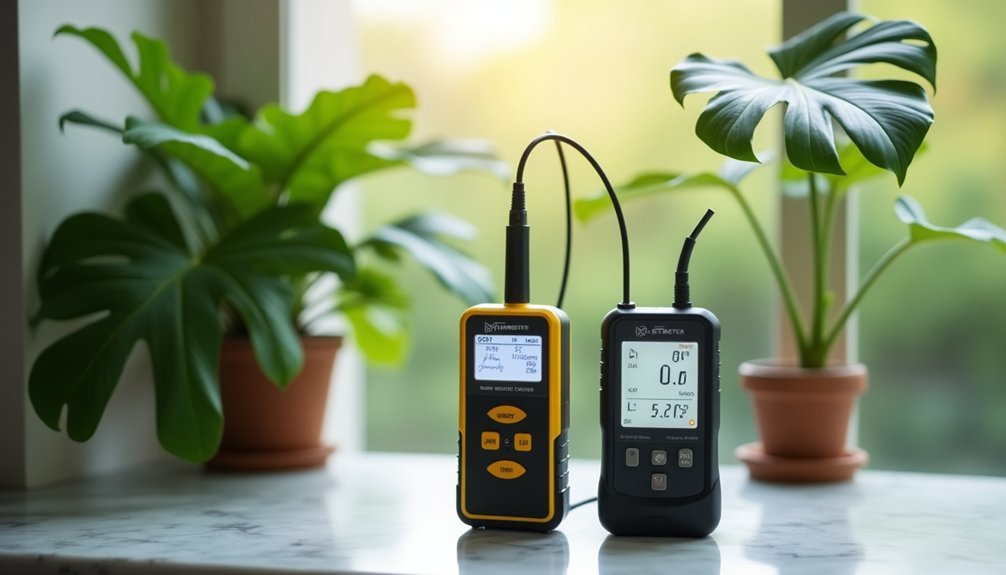
For serious indoor gardeners and aquarists who need precise light measurements, the BTMETER BT-881E stands out with its impressive range of 0.01 to 300,000 Lux.
You'll appreciate its quick 0.4-second response time and 270º rotating sensor that lets you measure light at tricky angles without moving the meter. The device stores up to 33 readings and includes a relative measuring mode to compare different light conditions. With accuracy ratings of ±4% for standard readings, you can trust its reliability for most indoor plant applications.
Despite some users noting it's less accurate than professional models, its 4.4-star rating from 790 customers suggests it's a solid choice for home use.
Best For: Indoor gardeners, aquarium enthusiasts, and hobbyist plant growers who need reliable light measurements without requiring professional-grade precision.
Pros:
- Wide measurement range (0.01 to 300,000 Lux) with quick 0.4-second response time
- 270º rotating sensor makes it easy to measure light at different angles
- Good memory capacity with 33 reading storage and relative measuring mode
Cons:
- Less accurate compared to professional-grade light meters
- Limited temperature testing capabilities
- Some users report inconsistent readings in certain lighting conditions
Kethvoz Digital Plant Light Meter with Rotating Sensor
Plant enthusiasts seeking professional-grade accuracy will appreciate the Kethvoz Digital Plant Light Meter's impressive range of 1-400,000 Lux. You'll benefit from its ±2% repeatability accuracy and dual functionality, measuring both light and temperature from -10℃ to 50℃. The rotating sensor (90 or 270 degrees) lets you position readings precisely for your indoor garden.
The backlit LCD display makes readings clear, while the data hold function stores up to 30 measurements. You'll find the MAX/MIN modes particularly useful for monitoring light fluctuations throughout the day. At just 139g, this compact meter fits comfortably in your hand, and the 15-minute auto shut-off preserves battery life.
Best For: Indoor gardeners, plant enthusiasts, and photography professionals who need precise light and temperature measurements with data logging capabilities.
Pros:
- Wide measurement range (1-400,000 Lux) with excellent ±2% repeatability accuracy
- Versatile functionality with both light and temperature measurements, plus 30-reading storage
- User-friendly design with rotating sensor and backlit LCD display for easy readings
Cons:
- Maximum reading limited to 3999, which may be restrictive for some professional applications
- 15-minute auto shut-off might interrupt longer monitoring sessions
- Temperature range (-10℃ to 50℃) may not be sufficient for extreme environment measurements
10 in 1 Indoor Air Quality Monitor with Portable Sensors
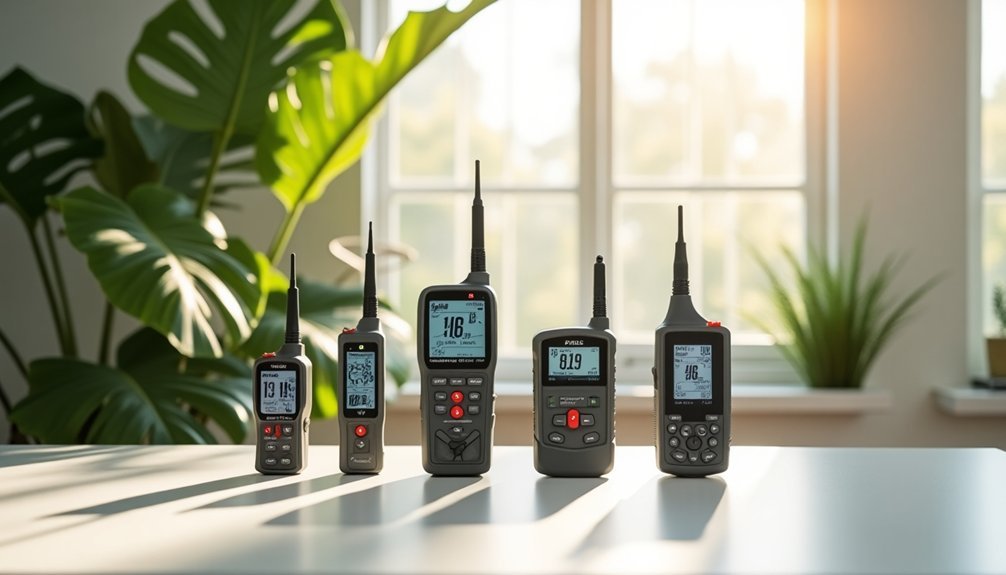
Safety-conscious indoor gardeners will appreciate the extensive 10-in-1 Indoor Air Quality Monitor, which goes beyond basic light measurement to protect both plants and people. You'll get real-time tracking of CO2, VOCs, CO, PM2.5, PM10, and formaldehyde levels using highly sensitive laser sensors.
The 5000 mAh rechargeable battery lets you move the device between your growing spaces with over 12 hours of standby time. You'll receive color-coded alerts when CO2 exceeds 2000 ppm, which is particularly useful if you're using wood-powered appliances or live in wildfire-prone areas. This Black E1 model undergoes rigorous testing to guarantee accurate readings for your indoor garden's environment.
Best For: Indoor gardeners, homeowners with air quality concerns, and anyone living near wildfire-prone areas who needs comprehensive air quality monitoring with portable capabilities.
Pros:
- Comprehensive 10-in-1 monitoring system covering all major air quality indicators
- Long-lasting 5000 mAh battery with 12+ hours of standby time
- Highly sensitive laser sensors for accurate PM2.5 and formaldehyde detection
Cons:
- May be more complex than needed for basic air quality monitoring
- Premium price point due to extensive feature set
- Requires regular battery charging for portable use
LATNEX LM-50KL Light Meter with Calibration Certificate
Professional growers and indoor plant enthusiasts will appreciate the LATNEX LM-50KL's impressive range of 200 to 200,000 lux, making it a robust choice for precise light measurements. You'll find the 1.5-meter flexible sensor wire especially useful when measuring light in hard-to-reach plant locations.
The device's accuracy matches within 2% of NIST certified meters, and it comes with a calibration certificate for assured reliability. The large LCD screen with data hold function lets you easily record readings, while the included carrying case keeps your investment protected. With a 200-hour battery life and versatility across all light source types, you'll have a dependable tool for optimizing your plants' lighting conditions.
Best For: Professional growers, indoor plant enthusiasts, and lighting specialists who need accurate light measurements in a range of 200 to 200,000 lux with reliable calibration.
Pros:
- High accuracy within 2% of NIST certified meters and includes calibration certificate
- Long 1.5-meter flexible sensor wire allows measurements in hard-to-reach areas
- Extended 200-hour battery life with low battery indicator and data hold function
Cons:
- Relatively high price point compared to basic light meters
- Mixed reviews regarding calibration consistency
- Larger size (10.39 x 5.08 x 3.11 inches) may be bulky for some users
BTMETER BT-881D Digital Illuminance Light Meter
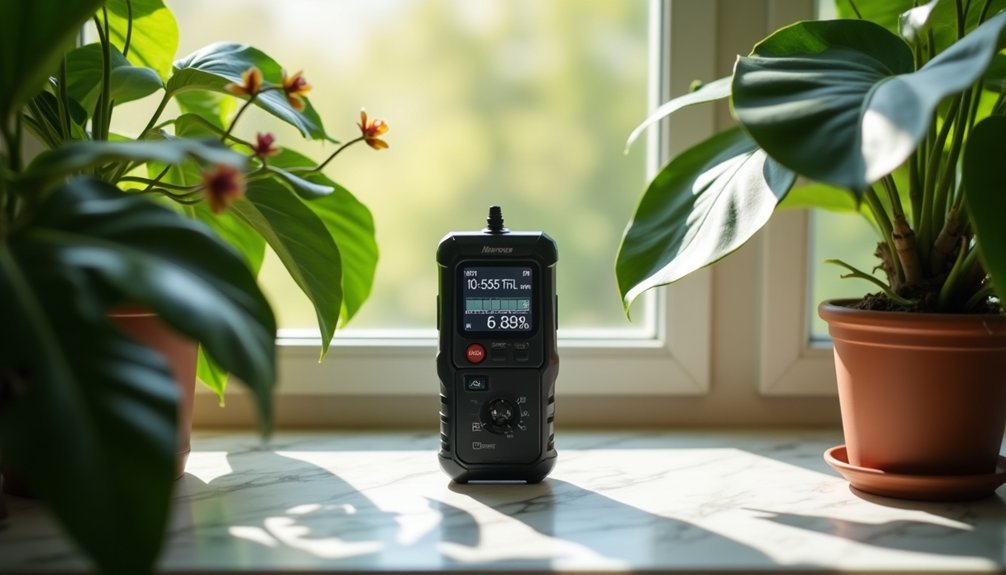
The BTMETER BT-881D shines as a versatile light meter with its 270º rotating sensor and impressive measurement range of 0.01 to 400,000 Lux. You'll appreciate its quick 0.4-second response time and ability to store up to 33 readings for comparison.
While it's accurate within 4-5% for most measurements and comes with a protective case, you should note it's not ideal for PAR readings with LED grow lights. The device has earned its #10 ranking in Photographic Light Meters thanks to its user-friendly features and reliable performance for indoor plant measurements. At 8.1 ounces, it's lightweight enough for extended use while monitoring your indoor garden's lighting conditions.
Best For: Indoor growers, photographers, and facility managers who need to measure general light intensity in various environments with a user-friendly, versatile device.
Pros:
- Wide measurement range (0.01 to 400,000 Lux) with quick 0.4-second response time
- 270° rotating sensor allows for flexible angle measurements
- Can store up to 33 readings for easy comparison and reference
Cons:
- Not suitable for accurate PAR measurements with LED grow lights
- Some users report inconsistencies when compared to professional equipment
- Limited to measuring light intensity only, without specialized features for specific applications
Factors to Consider When Choosing Essential Light Meters for Indoor Air-Filtering Flora
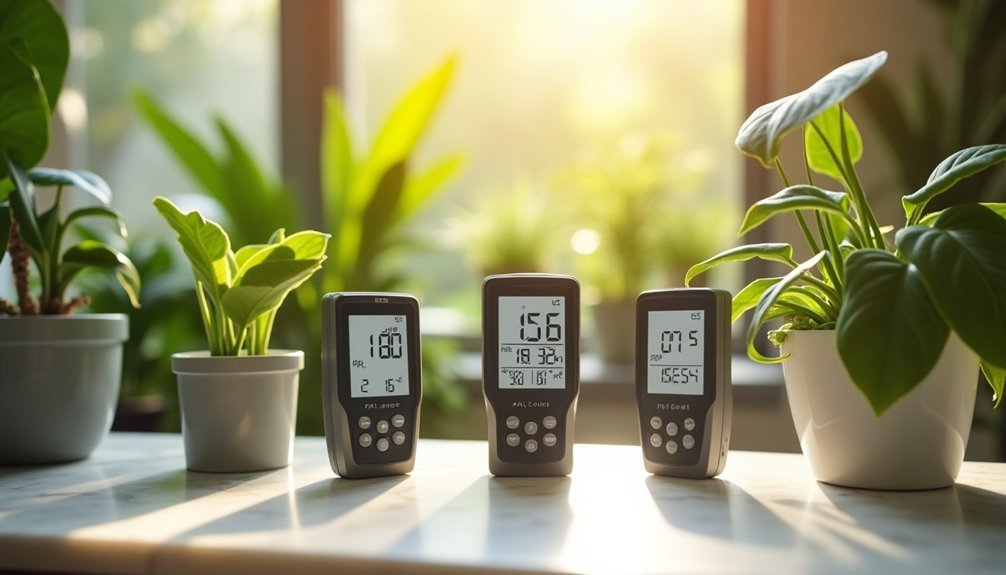
When selecting a light meter for your air-filtering indoor plants, you'll need to prioritize accurate measurement ranges and sensor capabilities that match your specific plant requirements. Your meter should feature reliable sensor rotation for reaching tight spots, along with data logging functions to track light patterns throughout the day. For ideal plant care, consider models that include temperature detection and extended battery life to guarantee consistent monitoring of your indoor garden's environment.
Measurement Range and Accuracy
Selecting an effective light meter requires careful attention to both measurement range and accuracy specifications. You'll want a device that starts measuring from 0.01 Lux to capture the subtle light conditions that sensitive indoor plants need. Look for meters offering accuracy within ±2% to ±5% to guarantee your readings are reliable.
For maximum versatility, choose a meter with a broad measurement range up to 400,000 Lux. This wide span lets you measure everything from dim ambient light to intense grow lights. Don't overlook response time – a meter that responds within 0.4 seconds will help you track real-time light changes. If you're planning to monitor your plants' conditions over time, opt for a model with memory storage capabilities to record and analyze multiple readings.
Sensor Type and Rotation
Since light meters come in various configurations, understanding sensor type and rotation capabilities is vital for accurate plant monitoring. You'll want to look for devices with rotating sensors that can swivel up to 270 degrees, as this feature lets you measure light levels from multiple angles without moving the entire unit.
For indoor plants placed in challenging spots, like corners or under shelves, a rotating sensor makes measurements considerably easier and more precise. The best sensors offer quick response times of 0.4 seconds and can sample 2-3 times per second, ensuring you get accurate readings efficiently. Look for models with accuracy ratings of ±4% to ±5%, as this precision is essential for monitoring your plants' light exposure. These specifications will help you maintain ideal growing conditions for your indoor flora.
Data Logging Capabilities
The ability to log and review light data sets your indoor gardening up for long-term success. When choosing a light meter, you'll want to look for models that can store multiple readings – ideally 30 or more data groups – so you can track light patterns across different areas of your growing space.
Consider devices with MAX/MIN measurement modes, which help you identify peak and lowest light levels throughout the day. This feature proves invaluable when determining the best placement for light-sensitive plants. You'll also benefit from a data hold function, letting you freeze readings while you document them. If you're monitoring plants in darker corners, select a meter with a backlit LCD display – it'll make reading measurements easier, especially during evening checks or in shadowy spots.
Environmental Temperature Detection
Beyond tracking light levels, modern light meters offer valuable temperature detection features that directly impact your indoor plants' health and air-filtering capabilities. You'll want to look for devices that measure temperatures between -10℃ to 50℃ with a precision of ±1℃ to guarantee accurate readings.
Temperature monitoring helps you prevent stress on your air-filtering plants, which can struggle when conditions exceed 30℃ or drop below 15℃. By choosing a light meter with integrated temperature detection, you'll get an all-encompassing view of your indoor growing environment. This dual functionality lets you make informed decisions about adjusting your heating or cooling systems to maintain ideal conditions.
Regular temperature monitoring alongside light measurements guarantees you're providing the best possible environment for your plants to thrive and effectively filter indoor air.
Battery Life Duration
Modern light meters offer impressive battery performance, with leading models providing up to 200 hours of continuous operation. You'll appreciate the convenience of energy-saving features like 15-minute auto shut-off, which preserves power when you're not actively using the device.
Most high-end models now come equipped with rechargeable lithium polymer batteries, featuring robust 5000 mAh capacities that deliver over 12 hours of standby time. You won't be caught off guard during significant plant light measurements, thanks to built-in low battery indicators that alert you when it's time to recharge.
When selecting your light meter, consider whether you prefer disposable or rechargeable batteries. While disposables might offer convenience, rechargeable options can reduce your long-term costs and environmental impact—an important factor if you're committed to sustainable gardening practices.
Display Screen Visibility
After considering your light meter's power source, let's focus on how well you'll see your readings. You'll want a backlit LCD screen that's easy to read in any lighting condition, especially when you're measuring dark corners where your plants might struggle.
Look for meters with high-resolution displays showing measurements down to 0.01 Lux for precise plant care. A larger screen will reduce eye strain and let you check readings from different angles while moving around your indoor garden. The data hold function proves invaluable when you need to freeze measurements for closer inspection. For quick assessment, choose models with color-coded indicators that instantly show if light levels meet your plants' needs. This visual feedback helps you make immediate adjustments to optimize your plants' growing conditions without second-guessing the readings.
Size and Portability Features
Efficient plant care requires a light meter you can easily maneuver through your indoor garden. You'll want to choose a device that weighs less than 140 grams to prevent arm fatigue when taking multiple readings throughout your space.
Look for models featuring built-in sensor covers, which protect the sensitive measuring components while you move between different plant locations. A rotating sensor head is particularly valuable, as it lets you measure light levels from various angles, especially in cramped spaces or when working around tall plants.
Don't overlook the importance of a carrying case – it's not just about convenience. A proper case protects your investment during storage and transport, ensuring your light meter stays accurate and functional for years to come.
Frequently Asked Questions
How Often Should I Calibrate My Light Meter for Accurate Readings?
You'll want to calibrate your light meter every 6-12 months for ideal accuracy. If you're using it professionally, calibrate more frequently. Always check before critical measurements or if you notice inconsistent readings.
Can Light Meters Detect Harmful UV Rays From Grow Lights?
You'll need a specialized UV light meter to detect UV rays, as standard plant light meters typically don't measure UV. If you're concerned about UV exposure, it's best to get a dedicated UV measuring device.
What's the Ideal Battery Life for a Professional-Grade Light Meter?
You'll want a professional light meter that lasts at least 50-100 hours on standard batteries. The best models offer replaceable batteries and low-battery indicators, so you're never caught off-guard during important measurements.
Are Smartphone Light Meter Apps Reliable Alternatives to Dedicated Devices?
While you can use smartphone light meter apps in a pinch, they're not as reliable as dedicated devices. Your phone's sensors have limitations and can't match the accuracy of professional light meters.
Do Weather Conditions Affect Light Meter Readings Through Windows?
Yes, weather conditions greatly impact your light meter readings through windows. You'll notice lower readings on cloudy days, while direct sunlight can create inconsistent measurements. Rain and snow will also reduce light transmission.
In Summary
You'll make an informed choice for your indoor plants' lighting needs with any of these top-rated meters. Don't forget to take into account your specific requirements, including measurement range, sensor quality, and additional features like temperature monitoring. Whether you're a beginner or experienced grower, these 2025 models offer the precision and reliability you need to maintain ideal growing conditions for your indoor garden.




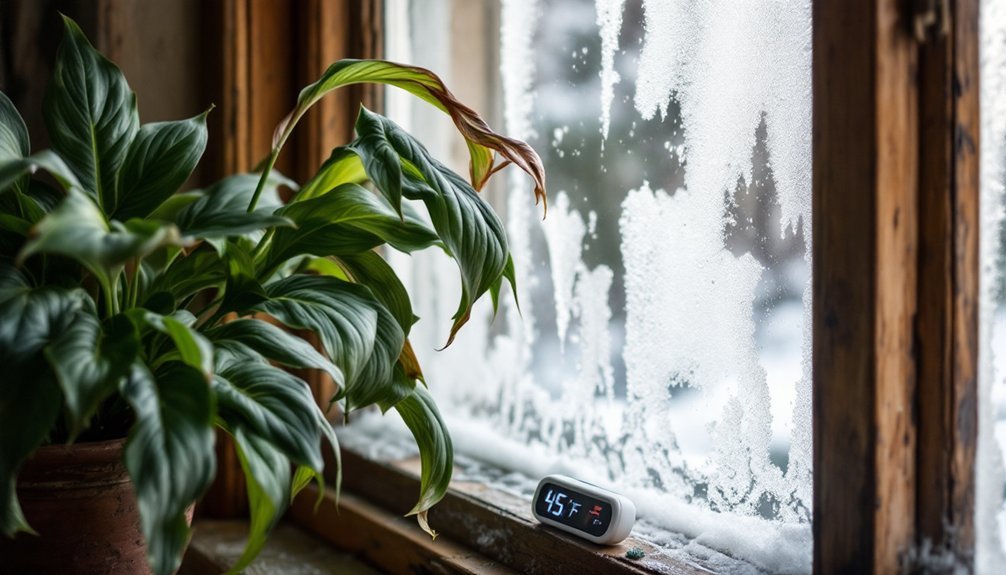
Leave a Reply